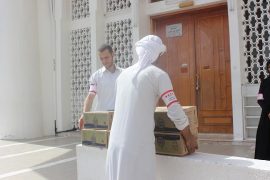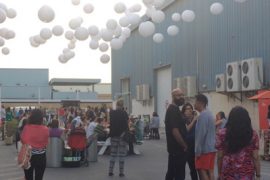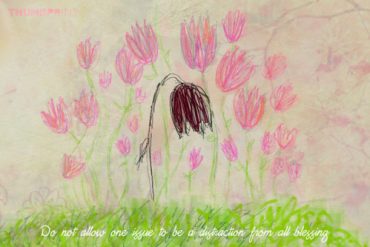Exploring the making of Talli – an Emirati traditional craft- and Bidwa, the social development programme under Irthi Crafts Council.

In a wide grey room at the Bidwa Center in Dibba Al-Hisn, Sharjah, the one recurring sound I heard was the clashing of wooden and plastic bobbins. This room is filled with middle-aged to elder Emirati women weaving in unison, and on entrance one might feel separate from the synchronization, yet the need to integrate oneself amongst them rises. “I’m sitting on the couch because of my back pain,” says a woman to my left, “but I have the metal stand to make it easier for me to weave.” She straightens her back and sighs. Now the spools of thread leap back and forth across her kajooja, a metal stand upon which a pillow is placed to balance out the straight line of weaving. A fifteen-centimeter wide bar of gold and black Talli lies on her grey kajooja; the triangular patterns gleaming in the March afternoon.
Talli, which is a traditional Emirati weaving by Emirati women, is mainly embellished on the collars of jellabiyas or its wrists, and sometimes it’s stitched on the ankles of sirwal pants, which are worn under the jellabiyas. It is a woven line comprised of colorful cotton threads combined with silver khousa, with its exemplary shine making it the main element of Talli. The original Indian-imported silver Zari threads that were used decades ago in making the Talli have now been replaced with synthetic metallic ribbons.

Keeping in line with weaving, the threads are placed on top of the kajooja so that the spools hang from the sides. If the width of the Talli is ten centimeters, then it would take approximately one day to complete one length. However, if the width increases, the time to complete it would increase as well. Other factors that determine the completion time of one bar of Talli include the symbols and patterns.
Fatma Al-Amiri, dressed in red thoub and vintage Arabian gold shows me her handmade Talli and explains the different patterns to me: “This one is called Garn Al-Ghazal, and it has a few colored threads, but it has a lot of silver khous as well.” She points at the pattern between Garn Al-Ghazal, which means the “horn of the deer”, and says the mnshar pattern, which means “saw”, complements the former in terms of design. The Talli is then sewn onto the desired fabric by hand. According to Al-Amiri, a pattern could have different names depending on the Emirate.
Some women such as Huda Abd Al Fattah, have learned new Talli patterns: “I’ve been coming to Bidwa for years, and over time I was able to learn new patterns while also perfecting my craft; these take a month or two to complete.” She shows me the Talli, which was designed by 28-year-old Saudi textile designer Azza Al-Sharif. “Usually my designs are inspired by the sea, the divers and even their tools,” says Al-Sharif. She has been working with the artisans at Bidwa for four years, creating the new Talli designs digitally before the artisans weave them. “Sometimes it’s trial and error,” she says, “We want to take this braid and make it 3D, to try and break the boundaries.” They show me a blue Talli embellished with pearls, and another woven with black leather, and it’s truly unlike anything I’ve seen before.
The Bidwa Social and Development Program, which is an initiative of Irthi Crafts Council, houses traditional Emirati crafts and provides employment for more than forty Emirati artisans in the area while offering vocational training. The center focuses on the welfare of their artisans and also empowers them through strengthening their skills.
With the aim of taking the craft to new markets, Bidwa took the artisans to international locations where they showcased their Talli, such as the Paris Prémiere Vision and Sao Paolo, Brazil. On both occasions they have experienced success, especially in Paris, where established and well-known designers expressed a desire to purchase the Talli for their own collections. It’s a compelling way to make their international debut, given that they’re the first to showcase in the Paris Prémiere Vision from the Middle East. These exemplary trips have allowed the artisans, who were once camera-shy, to get more used to being filmed and photographed by the media.
On the tenth of February 2018, Irthi Contemporary Craft Council released a video showcasing two artisans and a young woman sitting atop of a pick-up truck situated on the beach singing in Arabic while weaving. It is directed by Amira Tahjdin, who also wrote the script and filmed the short on a black image camera. The video was exceptional on all levels, from the creative imagery to the storyline, with the craftswomen genuinely weaving the Talli or reciting together folksongs and enjoying their time. “I have a style of mixing fiction and reality and with this it worked out that I used cast who were not actors. It’s about creating a safe space for people to be vulnerable and share a piece of themselves with the camera and the story,” explains Tahjdin.
To say the least, innovation and creativity go hand in hand with the efforts of both the craftswomen and the corporate team. While observing modernized crafts in Bidwa on one end, it was also a pleasure to see the women from the Irthi team exchange ideas about scouting locations for future projects. It appeared to me that the difference in generations mattered the least, and that collaboration was of the utmost importance. The combination was fascinating to see, where the elder Emirati women were clearly eager to tell their stories. The women at Irthi, the craftswomen, and the Irthi corporate team, all have one goal and that is to modernize and maintain the creativity of the nation’s craft through empowering those craftswomen in every way possible.
Official links for Irthi:
- Website: irthi.com
- Instagram: @irthicouncil
- Twitter: @irthicrafts




1 Comment